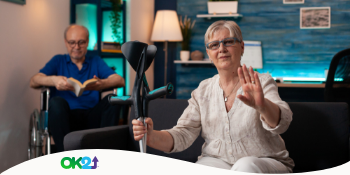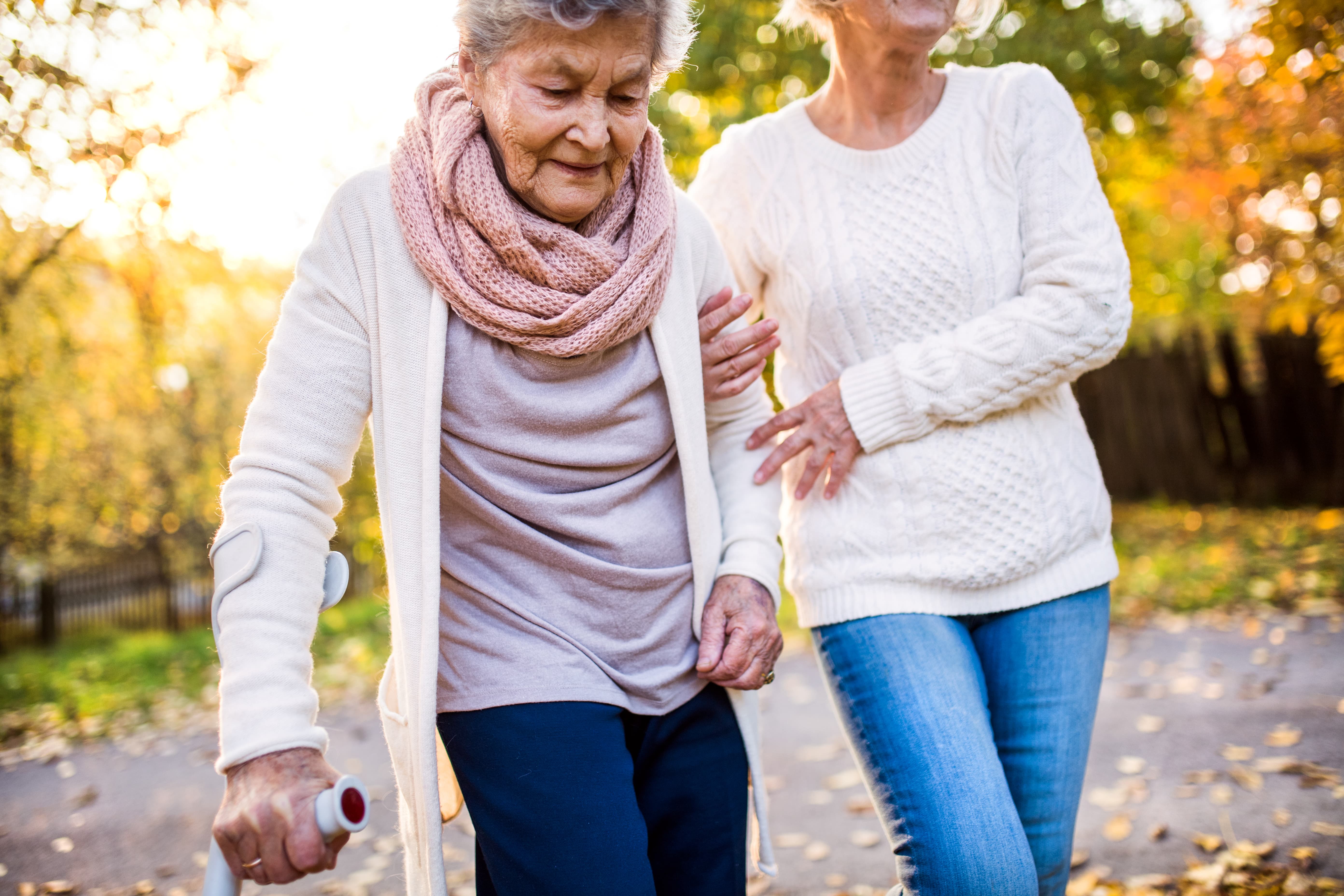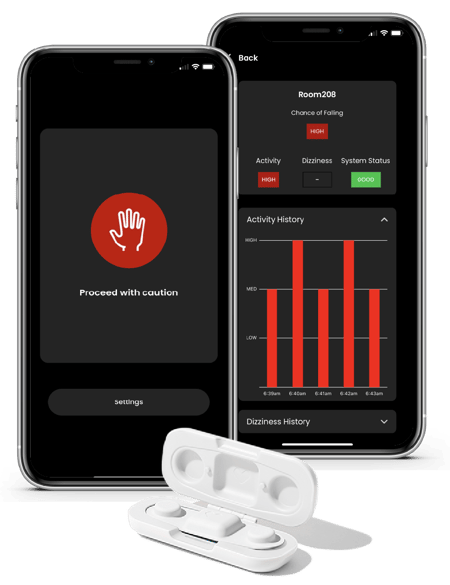In the United States, the reality of aging comes with a stark statistic: one in every four...


Top Fall Prevention Devices for Elderly Individuals
Every year in the United States, millions of older adults experience a fall. In fact, one in four adults aged 65 and older will experience a fall annually. These preventable events not only impact the individuals involved but also place a significant strain on hospitals, nursing facilities, and long-term care providers. As a result, there has been a rise in innovative prevention measures and technology solutions designed to address this growing public health concern.
In this blog post, we will examine the costs associated with falls, explain the differences between fall protection and prevention measures, and provide recommendations for the top fall prevention devices for elderly individuals.
The Cost of Falls
Falls among older adults aren’t just an inconvenience; they’re a serious public health concern with significant costs. Each year, more than $50 billion is spent on medical costs associated with falls – with long-term care facilities citing expenses upward of $380k annually per facility.
When a resident experiences a fall within a nursing facility, it inevitably leads to increased healthcare expenses. These costs can include medical care, such as hospitalization, doctor's visits, and rehabilitation services. Falls can also result in the need for more extensive care and ongoing monitoring, adversely impacting staffing, resourcing, and quality of care.
In addition to its financial implications, falls take a heavy toll on an individual's physical and emotional well-being. In older adults, falls can result in serious, sometimes fatal, physical injuries, including bone fractures and head injuries. Beyond the physical, falls can have detrimental impacts on an individual's functional independence and overall quality of life.
Although falls come with severe costs, they are also preventable, and by implementing proactive prevention measures, there are opportunities to mitigate falls and improve health outcomes for millions of older adults in the United States.
Fall Prevention vs. Protection
Before delving into fall prevention equipment for elderly adults, let’s look at the two strategies used to protect individuals before and after a fall: fall prevention and protection. While healthcare professionals often use these terms interchangeably, it's important to acknowledge their fundamental differences.
Fall Protection
Fall protection measures aim to ‘protect’ and minimize injuries when a fall occurs. These measures include a range of strategies and technologies, including soft flooring, bed rails, and fall alarms. While fall protection is undeniably essential in providing immediate safeguards, it should not be viewed as the sole strategy, as it primarily addresses the consequences rather than the underlying root causes of falls.
Fall Prevention
Fall prevention takes a more proactive approach, aiming to identify and address risk factors to reduce the likelihood of a fall. This holistic strategy includes a range of interventions, such as exercise programs, environmental modifications, medication reviews, and vision assessments, which collectively strive to create a safer environment and promote long-term fall risk reduction.
Fall Prevention Strategies and Best Practices
Fall prevention strategies and best practices typically include a combination of physical and environmental modifications designed to create a comprehensive approach to mitigating common fall risks. Here are a few of the most commonly practiced fall prevention strategies.
Fall Risk Assessments
Comprehensive fall risk assessments are essential for identifying and mitigating fall risks among older adults. Healthcare professionals commonly use these assessments to evaluate an individual's fall risk and craft a personalized fall prevention plan.
These assessments include the Tinetti Assessment Tool, Berg Balance Scale, Timed Up and Go (TUG) Test, Morse Fall Scale, Hendrich II Fall Risk Model, and STRATIFY. While the insights gained for each assessment differ, the goal remains the same: to create a safer and more secure environment for older adults by identifying their unique fall risk factors and implementing appropriate preventive measures.
Read more about each assessment and best practices for implementing them in long-term care facilities here.
Exercise and Strength Training Programming
Regular physical activity is one of the most effective ways to reduce the risk of falls, including exercises that improve balance, flexibility, and strength. It is common practice for nursing homes and long-term care facilities to implement exercise programs like Tai Chi or balance training to help residents maintain muscle tone, coordination, and stability.
Environmental Modifications
Identifying and mitigating potential hazards within an older adult's living space is an essential fall prevention strategy. These modifications include removing clutter, securing rugs, installing additional handrails, and improving lighting throughout the living space.
Regular Medication Reviews and Vision Assessments
Regular medication reviews can help reduce falls and enhance overall patient safety. It is well-known that certain medications can cause dizziness, drowsiness, or balance issues, which ultimately increases the risk and likelihood of falls. Adjusting or changing medications when necessary can significantly reduce this risk.
Age-related vision changes can contribute to falls. Regular eye check-ups can help detect and correct issues like cataracts, glaucoma, or macular degeneration, ultimately enhancing an individual's safety and well-being.
Education and Awareness
Educating aging adults and their families about fall risks and prevention strategies is another effective strategy. Sharing knowledge about potential hazards and safer behaviors, such as how to get in and out of the bathroom safely, can empower individuals to take proactive measures to prevent falls and improve their lives.
In addition to educating older adults, facilities can prioritize education and training for staff to further assist with fall prevention. Staff training may include specialized courses on fall risk assessment, proper techniques for helping residents with mobility, and recognizing early warning signs of potential falls.
Top Fall Prevention Devices for the Elderly
In recent years, there has been a significant increase in the development and adoption of technology solutions designed to protect elderly individuals from falls – beyond the strategies and best practices outlined above. These innovative devices and equipment leverage technological advancements and artificial intelligence to provide the next generation of fall prevention for aging populations.
In this section, we’ll explore two categories of fall safety technology: fall detection devices and fall prevention devices. It’s worth noting that fall detection devices are commonly referred to as “fall prevention,” despite their primary purpose being to assist after a fall has occurred.
Fall Detection Devices
Fall detection devices are well-established within the elder care community. Wearables, home monitoring systems, and smart home devices are invaluable tools for providing immediate assistance to elderly individuals after they’ve experienced a fall.
Here are some top fall detection devices for older adults:
- Personal Emergency Response Systems (PERS): PERS is one of the most common fall detection tools used today. These wearable devices can automatically detect the impact of a fall and immediately alert caregivers or emergency services.
- Popular Brands: LifeFone, MobileHelp, One Call Alert
- Video and Audio-Based Fall Detection: these sensors are typically installed throughout a home or living space and can remotely monitor activity, detect falls, and send alerts to caregivers or monitoring stations, as needed.
- Popular Brands: SimpliSafe, Ring Alarm, Vivant
- Voice-Activated Assistants: In addition to dedicated video monitoring systems, older adults can use devices like Amazon Alexa or Google Home to call for assistance or emergency services in the event of a fall.
These devices ensure that help arrives quickly and efficiently when someone experiences a fall, reducing the potential for further injury or complications. Advances in remote monitoring technology also pave the way for more proactive, personalized care for older adults living at home or in long-term care facilities.
Fall Prevention Devices
Fall detection devices have seen remarkable advancements in recent years. While these devices have demonstrated their effectiveness in promptly responding to falls, they have primarily focused on post-fall assistance rather than proactively preventing falls. In 2021, we introduced OK2StandUPOK2StandUP to the market to change just that.
The First-of-Its-Kind Fall Mitigation Solution: OK2StandUP
OK2StandUP is an innovative fall prevention device designed to proactively mitigate falls, prevent injuries, and improve the lives of millions of older adults. We developed this first-of-its-kind AI-powered technology to help organizations and families deliver reliable, efficient care to their residents and loved ones. This preventative tool allows caregivers to mitigate potential falls and injuries by stepping in before it is too late.
How It Works
OK2StandUP is a discreet, wearable device that utilizes advanced sensors and AI technology to monitor an individual's physical movements. Unlike other wearables, OK2StandUP monitors and tracks movement consistently, so there are no gaps or delays in alerting caregivers when something isn’t right.
OK2StandUP works by collecting real-time data on the wearer's movements. Its sophisticated algorithms analyze this data to identify any signs of instability or increased fall risk. When such signs are detected, the device promptly alerts the wearer and their designated caregiver or healthcare provider, allowing for immediate intervention.
This proactive approach empowers individuals to maintain their independence while significantly reducing the likelihood of falls and ultimately enhancing their overall quality of life as they age. With OK2StandUP, caregivers can simplify the caregiving process and streamline resource management for a more personalized and predictable caregiving experience.
Learn more about OK2StandUP and our innovative fall prevention solutions for professional and in-home caregiving.





